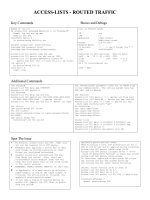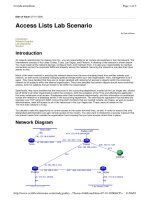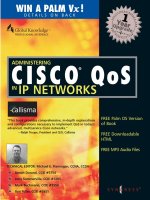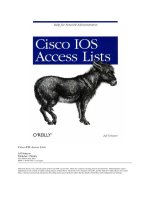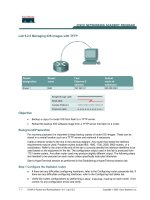Cisco Systems - Managing IP tracffic with access lists pptx
Bạn đang xem bản rút gọn của tài liệu. Xem và tải ngay bản đầy đủ của tài liệu tại đây (566.02 KB, 21 trang )
© 2002, Cisco Systems, Inc. All rights reserved.
© 2002, Cisco Systems, Inc. All rights reserved. 2
Managing IP Traffic with
Access Lists
Module 6
© 2002, Cisco Systems, Inc. All rights reserved. ICND v2.0—6-3
Objectives
Upon completing this module, you will be
able to:
•
Use Cisco IOS commands to configure standard
and extended IP access lists, and NAT/PAT,
given a functioning router
•
Use show commands to identify anomalies in
standard and extended IP access lists, given an
operational router
© 2002, Cisco Systems, Inc. All rights reserved. ICND v2.0—6-4© 2002, Cisco Systems, Inc. All rights reserved. 4
Access Lists and Their
Applications
© 2002, Cisco Systems, Inc. All rights reserved. ICND v2.0—6-5
Objectives
Upon completing this lesson, you will be
able to:
•
Explain the purpose of access lists and identify
potential applications
•
Describe how the Cisco IOS software processes
standard and extended access lists on inbound
and outbound interfaces
© 2002, Cisco Systems, Inc. All rights reserved. ICND v2.0—6-6
•
Manage IP traffic as network access grows
•
Filter packets as they pass through the router
Why Use Access Lists?
© 2002, Cisco Systems, Inc. All rights reserved. ICND v2.0—6-7
•
Permit or deny packets moving through the router.
•
Permit or deny vty access to or from the router.
•
Without access lists, all packets could be transmitted onto all
parts of your network.
Access List Applications
© 2002, Cisco Systems, Inc. All rights reserved. ICND v2.0—6-8
•
Special handling for traffic based on packet tests
Other Access List Uses
© 2002, Cisco Systems, Inc. All rights reserved. ICND v2.0—6-9
•
Standard
–
Checks source address
–
Generally permits or denies entire protocol suite
•
Extended
–
Checks source and destination address
–
Generally permits or denies specific protocols
Types of Access Lists
© 2002, Cisco Systems, Inc. All rights reserved. ICND v2.0—6-10
How to Identify Access Lists
•
Standard IP lists (1-99) test conditions of all IP packets from
source addresses.
•
Extended IP lists (100-199) test conditions of source and destination
addresses, specific TCP/IP protocols, and destination ports.
•
Standard IP lists (1300-1999) (expanded range).
•
Extended IP lists (2000-2699) (expanded range).
•
Other access list number ranges test conditions for other
networking protocols.
© 2002, Cisco Systems, Inc. All rights reserved. ICND v2.0—6-11
Testing Packets with
Standard Access Lists
© 2002, Cisco Systems, Inc. All rights reserved. ICND v2.0—6-12
Testing Packets with
Extended Access Lists
© 2002, Cisco Systems, Inc. All rights reserved. ICND v2.0—6-13
Outbound ACL Operation
•
If no access list statement matches, then discard the packet.
© 2002, Cisco Systems, Inc. All rights reserved. ICND v2.0—6-14
A List of Tests: Deny or Permit
© 2002, Cisco Systems, Inc. All rights reserved. ICND v2.0—6-15
•
0 means check value of corresponding address bit.
•
1 means ignore value of corresponding address bit.
Wildcard Bits: How to Check the
Corresponding Address Bits
© 2002, Cisco Systems, Inc. All rights reserved. ICND v2.0—6-16
•
For example, 172.30.16.29 0.0.0.0 checks all the
address bits.
•
Abbreviate this wildcard mask using the IP address
preceded by the keyword host (host 172.30.16.29).
•
Check all the address bits (match all).
•
Verify an IP host address, for example:
Wildcard Bits to Match a Specific IP
Host Address
© 2002, Cisco Systems, Inc. All rights reserved. ICND v2.0—6-17
•
Accept any address: any
•
Abbreviate the expression using the
keyword any.
•
Test conditions: Ignore all the address bits (match any).
•
An IP host address, for example:
Wildcard Bits to Match Any IP Address
© 2002, Cisco Systems, Inc. All rights reserved. ICND v2.0—6-18
•
Check for IP subnets 172.30.16.0/24 to 172.30.31.0/24.
•
Address and wildcard mask:
172.30.16.0 0.0.15.255
Wildcard Bits to Match IP Subnets
© 2002, Cisco Systems, Inc. All rights reserved. ICND v2.0—6-19
Summary
•
Access lists offer a powerful tool for network control.
These lists add the flexibility to filter the packet flow into
or out of router interfaces. Such control can help limit
network traffic and restrict network use by certain users or
devices.
•
An IP access list is a sequential list of permit and deny
conditions that apply to IP addresses or upper-layer IP
protocols. Access lists filter traffic going through the
router, but they do not filter traffic originated from the
router.
•
Access lists are optional mechanisms in Cisco IOS
software that you can configure to filter or test packets to
determine whether to forward them to their destination or
discard them.
© 2002, Cisco Systems, Inc. All rights reserved. ICND v2.0—6-20
Summary (Cont.)
•
Inbound access lists process incoming packets before
they are routed to an outbound interface, while
outbound access lists process packets to an outbound
interface.
•
The Cisco IOS software executes access list statements
in sequential order, so the first statement is processed,
then the next, and so on.
•
Address filtering occurs using access list address
wildcard masking to identify how to check or ignore
corresponding IP address bits.


